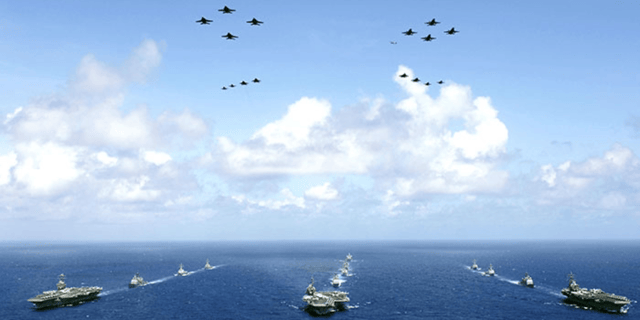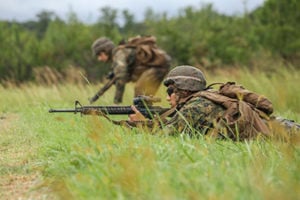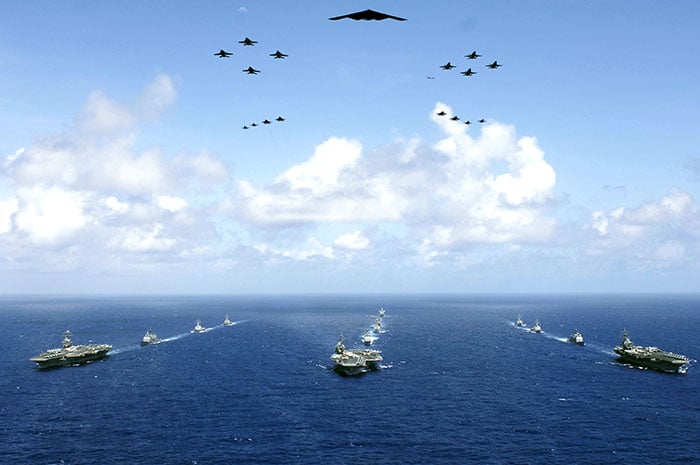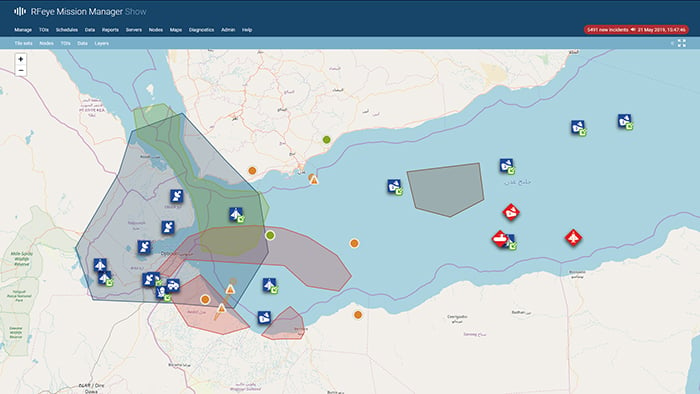
“I’m up. They see me. I’m down.”

Ground forces assaulting forward learn to minimize the physical signature they give to adversaries.
Many of our U.S. military customers are familiar with this refrain for minimizing a Soldier or Marine’s individual profile when assaulting forward toward an objective. We understand that an enemy combatant on the ground can see us because, in a direct engagement where rounds are exchanged, we have immediate feedback. We know if we’re giving up too large a profile.
Unfortunately, it’s often taken for granted that the signals we can’t see ourselves, our electromagnetic (EM) signature, can’t be seen by enemy equipment. In many ways, we assume that, if we can’t see it, it must not matter. And, for the past two decades of mostly counterinsurgency (COIN) operations, not many adversaries have been able to capitalize on EMCON to a large extent. However, as the U.S. and many of its NATO allies shift focus toward direct action against capable military threats, we again face potential adversaries with advanced capabilities to track us by our electronic transmissions – those signals we intended to send – as well as emissions we didn’t even realize were broadcasting.
It’s not just militaries who depend on electronic signals for communications, navigation, force protection, etc. EU agencies and U.S. federal partners also rely on electronic emitters throughout their daily operations. Whether using radios to protect and monitor borders, or tracking GPS or AIS signals for narcotics and human trafficking, RF signals are vital for operations and logistics. Unfortunately, the electronic transmissions of these agencies can also be tracked, jammed and/or hacked by shrewd individuals and organizations with the right tool sets.
EMCON: Don’t give an inch
Whether or not our radio operators, air crews, drone pilots, ship crews, agencies and cyber teams realize it, near-peers and technologically sophisticated civilian actors with hostile intent can exploit intentional or unintentional emissions as vital information for planning and even disinformation. This creates a strategic game of cat and mouse. As Sherlock Holmes would say, “The game is afoot” – whether or not we ever realize we’re playing.
We do know that adversaries can target EM emissions. In 2006, for example, a Chinese submarine breached a U.S. aircraft carrier battle group, surfacing less than five miles from the USS Kitty Hawk aircraft carrier in a show of force. Just last autumn, civil aviation and military operations in Norway were negatively impacted when the Russian electronic warfare (EW) units located and jammed NATO forces’ GPS signals. Even the Coast Guard and the maritime craft it supports have faced GNSS jamming from sophisticated civilian adversaries.

Emissions control (EMCON) is vital for airborne and shipborne assets to operate at peak capabilities.
As threats increase from what U.S. Marine Corps General Joe Dunsford calls the “four-plus-one: Russia, China, Iran, North Korea and violent extremism,” we are seeing a renewed emphasis on effective emissions control (EMCON). Across the Baltic and Black Seas, the Gulf of Aden, the Persian Gulf, the Sea of Japan and the South China Sea, effective EMCON is vital for ships and aircraft to maintain a strategic edge over capable and deadly adversaries. For NATO allies in eastern Europe, EMCON is equally vital for ground forces in the Army and Marines. And, while friendly forces ramp up technological capabilities in cyberwarfare, unmanned aerial vehicles (UAVs) and intelligence, surveillance and reconnaissance (ISR) assets, so too do potentially hostile forces. Giving an inch in unnecessary RF emissions can offer an enemy a mile of advantage.
Unfortunately, mistakes happen; sometimes personnel erroneously believe all emitters are turned off when EM signals are still being produced. Whether this is a mobile phone searching for signal, a GPS watch tracking location, a mechanical issue or an operator accidentally keying a mic, sometimes a full systems blackout, referred to in the US Navy as EMCON Alpha conditions, isn’t a true blackout. The best way to avoid this is to practice and test these protocols in situ and, as we’re fond of saying in software development, to “test early and test often.”
RFeye for EMCON evaluation and training
CRFS’s own RFeye solutions have been field-tested and proven to help friendly forces understand just what they might be giving away: how quickly an EM signature can be detected, how long it can be visible and even how quickly it can be exploited. With a rapid sweep speed, our sensors have regularly captured bursted, sub-microsecond signals. Our software has geolocated these signals in two or three dimensions using our time difference of arrival (TDOA or 3D TDOA) and angle of arrival (AoA) functions.
RFeye solutions don’t require an emitter to be located on the ground or in the air for it to be detected, recorded or geolocated. Our specialized signal detectors have tracked signals of fast-moving aircraft based on signals such as ADS-B and Air-to-Air (A2A) and Air-to-Ground (A2G) tactical data links. Our systems can geolocate drones on the ground or in the air, whether moving or stationary. With an incredibly low noise floor that lets us track aircraft across multiple U.S. states, our sensors can capture and geolocate weak signals.
A silent telescope – with microscopic clarity
RFeye Nodes and Arrays are designed to work quickly, across a large swath of EM spectrum, with incredible signal fidelity. The sensors themselves can collect signals from 9 kHz to 40 GHz, across a 100 MHz instantaneous bandwidth (IBW) “stare” – and resolution down to 1 Hz at full bandwidth. This means that our receivers can function both as a sort of telescope and microscope, allowing capture of wideband signals without sacrificing fidelity.
Of course, there is no advantage to gathering RF intelligence on our own EM “noise” by generating additional noise with our evaluation systems. Unlike active receivers, RFeye systems use passive collection to avoid broadcasting their presence. Additionally, when transmitting is possible, our intelligent receivers use a very low signal backhaul. Their embedded software rapidly collects and sorts signal data, discards what isn’t needed and sends only the relevant information in 16 bits across a mesh network or a wired connection. In stricter EMCON scenarios, this same software also enables the receivers to operate silently when combined with external storage.
Automation: Saving your seat
Sometimes an operator needs to step away from a real-time operation or event for any number of reasons. To help “cover down,” CRFS’s new automation suite, RFeye Mission, captures real-time RF signals without the need for an analyst to sit in front of the screen for the whole mission or write complex data collection scripts.

RFeye Mission provides real-time situational awareness for wargaming and real-world scenarios, automatically monitoring RF emissions 24/7 and sending out alerts instantly.
Mission does the heavy lifting. Operators can easily import RF monitoring schedules or create their own, but Mission makes it happen. Once tasked, it continuously scans the spectrum, reporting signals of interest and immediately triggering geolocations, external alerts and even recording. If a last-minute mission change comes down just before or even during an operation, Mission adjusts instantly. For post-mission reporting and analysis, it also generates reports automatically so that vital information can be passed to the right end users.
Maintaining a competitive edge
As adversaries become increasingly agile and technologically advanced, maintaining a competitive edge often requires looking inward. Our own erroneous transmissions, or those of our allies, can give away friendly tactics, techniques and procedures (TTPs): our locations, patrolling methods, equipment, manpower, etc. Poor EMCON broadcasts our capabilities to hostile forces. Effective EMCON, on the other hand, allows us to spoof or bluff should a conflict occur.
CRFS’s RFeye solutions are a reliable, field-tested method to silently monitor EMCON for Army, Navy, Air Force, Marine Corps and Coast Guard partners, as well as governmental agencies. With high signal fidelity across a wide band of the RF spectrum, as well as high sweep speeds, advanced military detector sets, and automation capabilities, the RFeye suite helps ensure that properly EMCON procedures are truly followed, and gives evidence of any violations.
Find out more
To request more information, or to see our RFeye solutions in action, please contact us at enquiries@crfs.com. You can also find more information in our white papers, blog and case studies.
